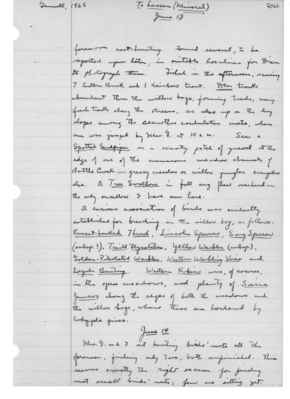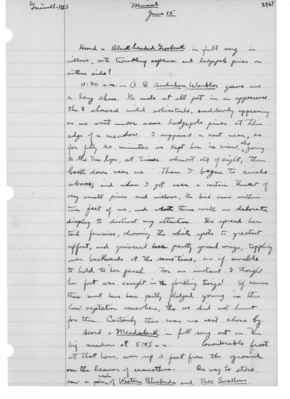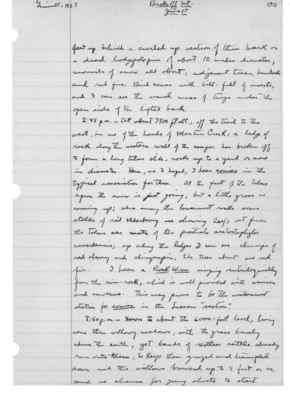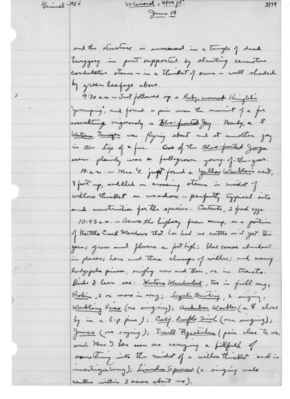Pages That Mention meadow
1925: Joseph Grinnell's field notes
S2 Page 6
Collector: Grinnell - 1925 Location: Lassen Section (Mineral) Date: June 13-14, 1925 Page Number: 2462
forenoon nest-hunting. Found several, to be reported upon later, in suitable locations for Dixon to photograph them. Fished in the afternoon, securing 7 Eastern Brook and 1 Rainbow Trout. Deer tracks abundant thru the willow bogs, forming trails; many fresh tracks along the streams, as also up on the dry slopes among the Ceanothus cordulatus mats, where one was jumped by Mrs. G at 10 a.m. Saw a Spotted Sandpiper on a scanty patch of gravel at the edge of one of the numerous meadow channels of Battle Creek - grassy meadows on willow jungles everywhere else. A Tree Swallow in full song flew overhead - the only swallow I have seen here. A curious association of birds was evidently established for birding in the willow bog, as follows: Russet-backed Thrush, Lincoln Sparrow, Song Sparrow (subsp.?), Traill Flycatcher, Yellow Warbler (subsp.), Golden-Pileolated Warbler, Western Warbling Vireo and Lazuli Bunting. Western Robins were, of course, in the open meadows, and plenty of Sierra Juncos along the edges of both the meadows and the willow bogs, where these are bordered by lodgepole pines. June 14 Mrs. G. and I out hunting birds' nests all the forenoon, finding only two, both unfinished. This seems exactly the right season for finding most small birds' nests; few are sitting yet.
S2 Page 11
Collector: Grinnell - 1925 Location: Lassen Section (Mineral) Date: June 15, 1925 Page Number: 2467
Heard a Black-headed Grosbeak in full song in willows, with twinkling aspens and lodgepole pines on either side! 11:30 a.m. - A female Audubon Warbler gave us a long chase. No male at all put in an appearance. The female showed wild solicitude, suddenly appearing as we went under some lodgepole pines at the edge of a meadow. I supposed a nest near, so for fully 20 minutes we kept her in view, she going to the tree tops, at times almost out of sight, then back down near us. Then I began to circle about; and when I got near a certain thicket of very small pines and willows, the bird came within ten feet of me, and went thru with an elaborate display to distract my attention. She spread her tail fanwise, showing the white spots to greatest effect, and quivered her partly spread wings, topping over backwards at the same time, as if unable to hold to her perch. For an instant I thought her foot was caught in the forking twigs! Of course there must have been partly fledged young in the low vegetation somewhere, tho we did not hunt for them. Certainly there was no nest close by. Heard a Meadowlark in full song out on the big meadow at 5:45 a.m. Considerable frost at that hour, even up 3 feet from the ground on the leaves of ceanothus. On way to store saw a pair each of Western Bluebirds and Tree Swallows.
S2 Page 18
Collector: Grinnell - 1925 Location: Lassen Section (Brokeoff Mt.) Date: June 17, 1925 Page Number: 2471
feet up behind a curled up section of thin bark on a dead lodgepole pine of about 10 inches diameter; mounds of snow all about; adjacent trees, hemlocks and red firs. Bird comes with bill-full of insects, and I can see the usual mass of twigs under the open side of the lifted park. 2:45 p.m. - At about 7500 ft. alt.; off the trail to the west, in one of the heads of Martin Creek; a ledge of rock along the western wall of the canyon has broken off to form a long talus slide, rocks up to a yard or more in diameter. Here, as I hoped, I hear conies in the typical association for them. At the fast of the Talus apron the snow is just going, but a little grass is coming up; also among the lowermost rocks some stalks of red elderberry are showing leaf; out from the Talus are mats of the prostrate arctostaphylos nevadensis; up along the ledges I can see clumps of red cherry and chinquapin; the trees about are red fir. I hear a Rock Wren singing ventriloquially from the rim-rock, which is well provided with crevices and caverns. This may prove to be the westernmost station for conies in the Lassen "section." 3:50 p.m. - Down to about 600-foot level, having come thru willowy meadows, with the grass barely above the earth, yet bands of restless cattle already run onto them, to keep them grazed and trampled down and the willows browsed up to 5 feet or so, and no chance for young shoots to start.
S2 Page 24
Collector: Grinnell-1925 Location: Mineral, 4800 ft. Date: June 19 Page Number: 2479
and the structure is ensconced in a tangle of dead twiggery in part supported by slanting ceanothus cordulatus stems - in a thicket of same - well shaded by green leafage above.
9:30 a.m. - Just followed a Ruby-crowned Kinglet's "yerruping," and found a pair upon the summit of a fir assaulting vigorously a Blue-fronted Jay. Nearby, a (female) Western Tanager was flying about and at another jay in the top of a fir. One of the Blue-fronted Jays seen plainly was a full-grown young-of-the-year.
10: a.m. - Mrs. G. just found a Yellow Warbler's nest, 8 feet up, saddled on crossing stems in midst of willow thicket on meadow - perfectly typical site and construction for the species. Contents, 2 fresh eggs.
10:45 a.m. - Across the highway from camp, on a portion of Battle Creek Meadows that has had no cattle on it yet this year; grass and flowers a foot high; blue camas abundant in places; here and there clumps of willow; and many lodgepole pines, singly now and then, or in tracts. Birds I hear are: Western Meadowlark, two in full song; Robin, 2 or more in song; Lazuli Bunting, 2 singing; Warbling Vireo (one singing); Audubon Warbler (a (female) close by in a l-p pine); Calif. Purple Finch (one singing); Junco (one singing); Traill Flycatcher (pair close to me, and Mrs. G has seen one carrying a billfull of something into the midst of a willow thicket and in investigating); Lincoln Sparrow (a singing male centers within 3 acres about us).
S2 Page 25
Author: Grinnell-1925 Location: Mineral, 4800 ft. Date: June 19 Page Number: 2480
Later: found the Traill Flycatcher's nest some 7 feet up in a crotch of slender willow stem in the midst of an isolated willow clump in the meadow - just in process of construction. In a tract of old lodge pole pines a little farther along, a crowd of birds was distraught over something, tho I failed to find what the threatening danger was. The crowd included: Juncos, a pair of Robins, a Lincoln Sparrow, a Pigmy Nuthatch (the first I have seen in the Lassen "section"), a Hammond (or Wright) Flycatcher, several Chipping Sparrows, and a pair of Audubon Warblers. Nearby was a (female) White-headed Woodpecker.
As to mammals: winter earthcores of Thomomys monticola occur in places where the ground is well-drained at the sides of meadows but not out in them. The common chipmunk is Eutamias amoenus, about logs overgrown with snowbushes, but they are very quiet now; two visit camp, but so far are shy. A (female) Eutamias senex was trapped in a neighbor's camp yesterday morning at 5 o'clock. Last evening just before sundown, Dixon shot an old male jack-rabbit (Lepus c. californicus) in a tract of sparse snowbush. Mrs. G. has seen another partly grown one in the same vicinity. This must be the extreme easternmost limit of this subspecies in the "section". Also, Mrs. G. and Dixon have both seen individuals of the snow-shoe rabbit (Lepus w. klamathensis).




